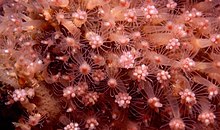
The chondrophores or porpitids are a small group of hydrozoans in the family Porpitidae. Though it derives from an outdated name for this lineage, some still find the term 'chondrophore' useful as a synonym to 'porpitid' in discussions of the two genera contained therein, Porpita and Velella.

Velella is a monospecific genus of hydrozoa in the Porpitidae family. Its only known species is Velella velella, a cosmopolitan free-floating hydrozoan that lives on the surface of the open ocean. It is commonly known by the names sea raft, by-the-wind sailor, purple sail, little sail, or simply Velella.

Hydroidolina is a subclass of Hydrozoa and makes up 90% of the class. Controversy surrounds who the sister groups of Hydroidolina are, but research has shown that three orders remain consistent as direct relatives: Siphonophorae, Anthoathecata, and Leptothecata.

Leptothecata, or thecate hydroids, are an order of hydrozoans in the phylum Cnidaria. Their closest living relatives are the athecate hydroids, which are similar enough to have always been considered closely related, and the very apomorphic Siphonophorae, which were placed outside the "Hydroida". Given that there are no firm rules for synonymy for high-ranked taxa, alternative names like Leptomedusa, Thecaphora or Thecata, with or without the ending emended to "-ae", are also often used for Leptothecata.

Plumularioidea is a superfamily of hydrozoans in the order Leptothecata.

Rhopalonematidae is a family of hydrozoans. The family comprises 15 genera and 36 species.

Porpita porpita, or the blue button, is a marine organism consisting of a colony of hydroids found in the warmer, tropical and sub-tropical waters of the Pacific, Atlantic, and Indian oceans, as well as the Mediterranean Sea and eastern Arabian Sea. It was first identified by Carl Linnaeus in 1758, under the basionym Medusa porpita. In addition, it is one of the two genera under the suborder Chondrophora, which is a group of cnidarians that also includes Velella. The chondrophores are similar to the better-known siphonophores, which includes the Portuguese man o' war, or Physalia physalis. Although it is superficially similar to a jellyfish, each apparent individual is actually a colony of hydrozoan polyps. The taxonomic class, Hydrozoa, falls under the phylum Cnidaria, which includes anemones, corals, and jellyfish, which explains their similar appearances.
Csiromedusa medeopolis is a species of hydrozoan described in 2010. It was discovered in the estuarine waters of the River Derwent near to the Commonwealth Scientific and Industrial Research Organisation's Marine and Atmospheric Research branch in Hobart, Tasmania, Australia. C. medeopolis has been described as presenting a new family and genus as well as species.

Aequoreidae is a family of hydrozoans, sometimes called the many-ribbed jellies or many-ribbed jellyfish. There are approximately 30 known species found in temperate and tropical marine coastal environments. Aequoreids include Aequorea victoria, the organism from which the green fluorescent protein gene was isolated.

Pandeidae is a family of hydroids in the class Hydrozoa. Like other jellyfish there is usually a mature medusa form which is pelagic and reproduces sexually and a hydroid or polyp form which is often benthic and reproduces asexually by budding.
Bougainvillia aberrans is a marine invertebrate, a species of hydroid in the suborder Anthomedusae. It was first described by Dale Calder in 1993. They have four radical clusters of marginal tentacles. Bougainvillia aberrans is found in Bermuda in the western North Atlantic Ocean.

The tubular sponge hydroid is a species of hydroid cnidarian. It is a member of the family Tubulariidae. These animals usually grow embedded in sponges.

Candelabridae is a small family of cnidarians within the class Hydrozoa. Myriothelidae Hincks, 1868 and Symplectaneidae Fraser, 1941 are now accepted as synonyms of this family.

Solanderia is the sole genus of hydrozoans in the monotypic family Solanderiidae. They are commonly known as tree hydroids or sea fan hydroids.

Porpita prunella is a marine species of hydrozoan organisms within the family Porpitidae. It consists of colonies of zooids. Very little is known about this species, as there have been no confirmed sightings since its discovery in 1801 and naming by Haeckel in 1888. Being in the chondrophore group, it is likely that its behaviour is similar to the other species of the genera in the family. However there are also serious doubts as to its very existence as a separate species and may in fact be a synonym for Porpita porpita instead.

Capitata is a suborder of Hydrozoa, a class of marine invertebrates belonging to the phylum Cnidaria.

Filifera is a suborder of hydrozoans in the order Anthoathecata. They are found in marine, brackish and freshwater habitats.

Bathyphysa conifera, sometimes called the flying spaghetti monster, is a bathypelagic species of siphonophore in the family Rhizophysidae. It is found in the northern Atlantic Ocean and off the coast of Southwestern Africa and California.

Leuckartiara is a genus of cnidarians belonging to the family Pandeidae.
Atyoida is a genus of freshwater shrimp in the family Atyidae. There are four species in the genus, each endemic to a different island group. The type species, Atyoida bisulcata, is endemic to Hawaiʻi and described by John Witt Randall in 1840.
















